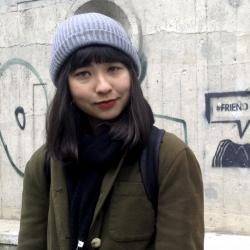Walking up Skólavörðustígur one notices that the path of travellers on the sidewalks is akin to that of a drunken college student wandering home after a long night at the bar. The wanderers swerve and sway with little regard to the large stroller approaching rapidly from behind, the jogger whose momentum is about to be torn in two, or the looming threat of a stubborn lamppost. But it’s not booze to blame; it’s beauty.
The area induces a 10-block-long state of head-in-the-clouds. The quintessentially “Reykjavík” sights of Skólavörðustígur are distracting, to put it lightly, and dangerous, to be real. Which is why we thought it would be a good idea to patrol for risk zones during a summer-long outdoor art exhibit titled “Under the Open Sky,” in the interest of public safety, of course.
HEAD IN THE SKY
The exhibit features works by 94 artists dispersed about the central district of Reykjavík. Front yards, side yards, windowsills and empty walls have all become exhibit spaces from May 25 to August 25, or as long as the pieces can withstand the weather. Some are conspicuous, like a chained ring of broken-glass bodies by Laufey Jensdóttir marking the corner of Óðinsgata and Skólavörðustígur. Others are subtler, like a 10-square hopscotch on the sidewalk, Erla Þórarinsdóttir’s way of encouraging a bouncing departure from Hallgrímskirkja. While traversing this stretch, one must be especially aware of the second-story and rooftop works, as they become high-risk zones for eyes-to-the-sky, feet-on-the-ground collisions.
Just off of the main drag, the self-guided tour leads guests into the charming neighbourhood of Óðinstorg. Óðinstorg itself is a work of art, being the oldest residential neighbourhood in Reykjavík. The buildings were all built in the early 20th century, and the streets are named after Nordic Gods.
The biggest threat in this region is not pedestrian collisions, but rather the deluded drifter. Streets in this neighbourhood kink and curve, they dead end and then start back up again ten meters to the right, they run perpendicular and diagonal and parallel to each other all at once. Nothing about this neighbourhood is intuitive. The sense of directionless-ness that Óðinstorg induces actually enhances the experience of the exhibit. Unlike museums, which push the viewer from one room to the next, there is a refreshing sense of freedom. Nothing is stale in the open air, and nothing is dull when you’re there by choice.
DRIFTING WITH PURPOSE
Back in the 1940s, a man named Guy Debord picked up on the benefits of this free movement, and through it he carved out and defined the theory of the dérive. Dérive translates literally to drift in English. It was a practice, a mode of navigating a city by not navigating it at all. Skip the Google Maps and the Já.is. What Debord realised with dérive is that no matter how familiar one is with a city, how engrained it is in them, there is always a new experience to be had. By allowing oneself to be guided by aesthetics, the most familiar places become new and original again.
Even though visitors are provided graphic street maps with numbered locations of each work, the spirit of dérive is present in the exhibit. Alongside the deliberate tour-taker, we have the involuntary viewer; the one who just happens to cross Jóna Thors’ vibrant bloom of horizontal daisies stretching across the street on a walk home from work; the one who is stopped, midway to the bakery, to press his ear against a mounted wooden box by Ólöf Jóhannsdóttir that emits a stream of women’s narratives in Icelandic. In this sense there is hardly any freedom of choice involved. You are exposed, whether or not you set out that morning craving an impromptu serving of Art.
So, aside from the occasional iPad-happy looker, the exhibit as a whole has the opposite effect than what was anticipated. It makes pedestrians of Reykjavík, locals and foreigners alike, more careful observers. Many make the daily stroll through Óðinstorg and may have never noticed that it contains the most vibrantly yellow tulip in all of Iceland, or the most gnome-infested stoop in, perhaps, the world. The artworks themselves blend well with their surroundings, but don’t disappear into them. These subtle additions, while impressive in themselves, serve most importantly as a reminder to look right and left instead of just straight ahead. So slow your stroll, get a little lost, and take it all in.
Buy subscriptions, t-shirts and more from our shop right here!


















